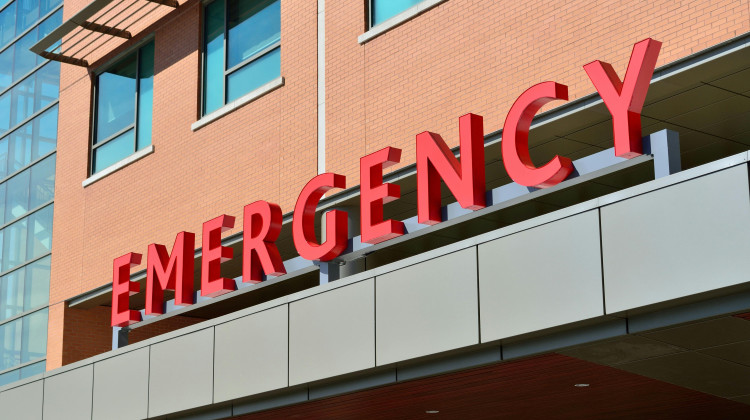
According to a new analysis by health care consulting firm Kaufman Hall, some of the financial strains can be traced back to the COVID-19 pandemic.
PixabaySome Indiana hospital budgets are in the red as the state hospitals' cumulative operating margin continues to be under 1%, according to a new analysis by health care consulting firm Kaufman Hall.
The financial strains can be traced back to the health care workforce shortage and an increase in labor expenses during the COVID-19 pandemic.
The recent analysis shows that, overall, Indiana hospitals are struggling to bounce back, while other states are making significant strides.
Indiana hospitals generated $358 million in operating income –– the profit after deducting operating expenses –– last year, but it’s still a roughly $731 million decline compared to pre-COVID-19 pandemic baselines. Last year’s cumulative operating margin in Indiana was 0.9%, compared to the average 2.3% margin across the country. In 2022, hospitals across Indiana operated on a negative 2% loss.
“While conditions improved slightly for Indiana hospitals relative to last year, their financial sustainability remains at risk,” said Erik Swanson, senior vice president of data and analytics at Kaufman Hall. “To be in good financial standing, a hospital should operate within a 4-6% margin. At current levels, Indiana hospitals are barely breaking even, which is simply unsustainable.”
The report doesn’t break down the financial standing of individual hospitals across the state. According to financial statements, the state’s largest hospital system, Indiana University Health, increased its in-patient and out-patient surgeries and medical inpatient discharges, boosting its operating revenue to $8.64 billion. The hospital giant’s operating margin was a healthy 4% last year.
Beacon Health System had an operating margin of 3%. CEO Kreg Gruber said the organization had to change how they serve patients in order to juggle the rising costs, as well as the increase in Medicare and uninsured community members that “make the chances of maintaining a positive margin more and more challenging.”
Natalie Russell, communications manager for the Indiana Hospital Association, said smaller hospitals especially in rural areas are struggling. According to Russell, more rural hospitals have closed over the past decade compared to hospitals in cities.
Reid Health, a hospital system with locations in multiple rural Indiana towns such as Connersville, Hagerstown and Richmond, implemented a performance improvement plan last year to evaluate its operations and build a more sustainable future. But Craig Kinyon, the hospital system’s president and CEO, said they need support.
Nationally, more than 700 rural hospitals –– a thirdof all rural hospitals are at risk of closing, according to the Center for Healthcare Quality and Patient Reform.
“Hospitals still continue to face significant headwinds when it comes to the unprecedented workforce crisis, the skyrocketing cost of drugs, labor, equipment, and the lingering supply shortages that are continuing to threaten access to care,” Russell said. “We are hoping that [during] the next legislative session, we will be able to get direct financial support with the next budget cycle moving forward.”
Indiana hospitals were able to reduce their contract labor, such as travel nurses who come to fill gaps in care, but the organizations still had to contend with the rising cost of operating expenses. Inflation is one of the reasons operating expenses increased higher than the national growth last year.That’s partially what led to a 10.3% median increase in medical supplies, and a nearly 10% increase in non-labor expenses.
Indiana hospitals were able to increase free care to patients last year by 22%, but still have a long way to go in order to increase their operating margins, according to a statement from the IHA.
The state’s low Medicaid reimbursement rates, which haven’t increased in over 30 years, are also causing the financial dip, according to Russell. Indiana hospitals receive 57 cents for every dollar of care they provide. That ranks far below the national average of 88 cents in 2020.
Additionally, Indiana’s Hospital Assessment Fee — the tax hospitals pay to help fund the state’s Medicaid program — increased by almost 10%, a much higher rate than hospitals nationally.
But organizations like Hoosiers for Affordable Healthcare hope the legislature will do more to lower hospital prices, especially at the state’s largest hospital systems. According to an analysis by the Employers Forum of Indiana in 2023, the largest five nonprofit hospital systems collect 76% of commercial patient revenue in the state.
Matt Bell, chief policy advocate for Hoosiers for Affordable Healthcare, said those large nonprofit hospital systems serve the vast majority of people in Indiana, which is why Indiana residents pay some of the highest prices in the country for hospital care –– according to a RAND Corporation study that looked at medical claims from 2018 to 2020.
“A system in which large nonprofit hospitals bank billions of dollars in cash reserves and generate profit margins that are five times larger than the national average, while smaller rural hospitals struggle is a broken system,” Bell said. “Sadly, that is the situation in Indiana.”
Contact WFYI’s health reporter Elizabeth Gabriel at egabriel@wfyi.org.
 DONATE
DONATE








 View More Programs
View More Programs

 Support WFYI. We can't do it without you.
Support WFYI. We can't do it without you.